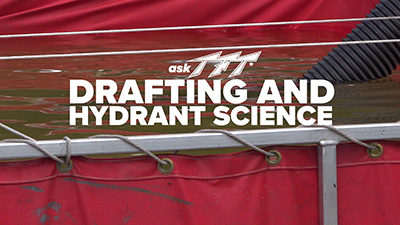What does it really mean to have a 1500 GPM pump?
When you want to understand how much water your pump can move, it’s important to have a solid understanding of what a pump rating actually is and how it’s determined. Let’s dive in.
Pump Rating Conditions
One really important thing to understand about pump ratings is that they are determined under very specific conditions.
The first is that the pump must be operating from a draft. So, a 1500 GPM pump can flow 1500 GPM from a draft at a pump discharge pressure (PDP) of 150 PSI.
According to NFPA 1901 standards, pumpers have to be able to achieve their rating with no more than 20 feet of hard sleeve connected to an intake. Depending on the pump size, they may be able to use multiple intakes depending on whether 6” hard sleeve is being used. A 1500 GPM pump can use a maximum of two intakes to achieve its rated capacity.
Another stipulation that must be met during a pump capacity test is the maximum amount of lift that is present. For pumps up to 1500 GPM, the maximum lift is 10 feet. 1750 GPM pumps can have eight feet of lift and 2000 GPM pumps have a maximum lift of six feet.
The takeaway from this is that pump ratings are done under very specific testing parameters. In the real world, you may not be able to meet that laboratory setting for a variety of reasons.
Pump Ratings in the Real World
Drafting
In the real world, you may not be able to draft with 20 feet of hard sleeve. Instead, you may need 30 or 40 feet of hard sleeve connected to an intake to get your target flows.
In the rural environment, many departments aim for 1000 GPM when they operate from a static water source. This is a typical goal for filling mobile supply apparatus because it is efficient. Your real-world environment will probably not mimic the laboratory settings, so you need to keep that in mind as you set up your draft.
Hydrants
Your pump's rated capacity is determined at a draft. Hooking up to a fire hydrant is completely different. In this scenario, the limiting factor for how much water you can get is the hydrant itself, not the pump’s rated capacity.
If you hook a 1500 GPM pumper to a 2000 GPM hydrant, you can expect flows of 2000 GPM out of that pumper because the hydrant is giving 2000 GPM. On the flip side of that scenario, if you take a 1500 GPM pumper and hook it to a 500 GPM hydrant, you are only going to be able to flow 500 GPM. The pumper does not create water, so you can only use what the hydrant provides.
A special thank you to Andy Soccodato of The Water Thieves for being our special guest on this Ask TFT episode!
